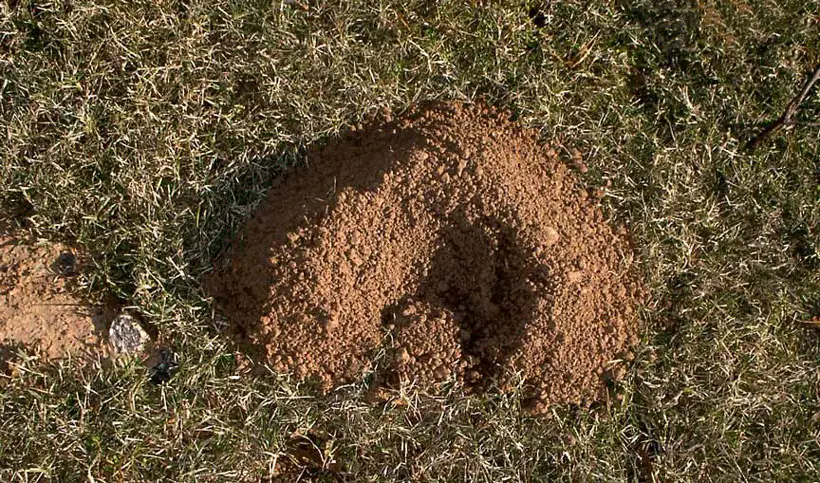Why Do Gophers Make Mounds?- Digging Deep for the Answer
Gophers are notorious little mammals that spend most of their lifespan underground excavating tunnels. In the process of digging tunnels, they leave piles of dirt in a distinct characterized shape on the ground, which we all know as a gopher mound.
As dull and dirty as they look, they can improve soil aeration and drainage. Plus, it’s quite beneficial for healthy root growths of plants as they can be rich in nutrients. But have you ever wondered why do gophers make mounds?
The answer is simple, the mounds are the by-product of the digging. But there is more to it. Understanding why gophers make mounds is crucial for effective pest control as it helps identify the location and extent of gopher activity and can aid in preventing infestations.
In this article, we’re going to shed some light on everything you need to know about mounds and Gopher behavior. So, let’s get to it!
Mound Formation of Gophers
To get rid of gopher tunnels, you need to understand how gophers form their mounds. Moreover, what do gopher mounds mean? Well, they are the result of the digging activities of these rodents.
Gophers are expert tunnelers. When they make tunnels for easy underground access, they dig out the dirt and pile it on the surface. That is what we call a mound.

Gophers use their sharp claws and strong forefeet to dig these tunnels. These tunnels can expand up to several hundred feet with multiple entrances and exits. Plus, these tunnels can go up to six feet deep under the ground.
The mounds are distinctive in shape. Different gopher species make different shapes of mounds. By the shape, you can tell which species you’re dealing with.
For example, the pocket gophers make the mounds commonly in crescent shapes, while other species may make them conical or flat in shape. So let me tell you a bit about their type and shape. That might help you in your task of managing gopher mounds.
Types of Mounds and Their Functions
In general, there are mainly two types of mounds that gophers create-

Feeding Mounds
This type of mound can be created when the gopher is searching for food. They typically span around a few inches to a few feet. It functions as an indication where the gopher is actively excavating and may help you to find the garden pests and get rid of them.
Plugging mounds
These mounds are more visible and conical in shape than the feeding mounds. Its sole purpose is to prevent any predator from entering the gopher’s hive and prey.
Purposes of the Tunnels
The gophers don’t excavate as a hobby. Their burrow system is intricate and well-planned. They do the digging mainly for food, shelter, or a hiding spot from predators. Plus, the different sections of the tunnels serve different purposes.
Some of the section is used for sleeping while others might be used for eating purposes. You can find some storage facilities too. There are also some dead ends to the tunnels to confuse and deter predators. Plus, they are quite sanitary too. Some of the tunnels are used as latrines.
Implications of Gopher Mounds
Gopher mounds might seem like a pile of soil and dirt but it plays a vital role in ecology. These mounds can have severe negative effects on the water flow in the soil and also on your plant’s roots. Plant damage occurs in this sort of case.

Here are three examples-
1. Compacted Soil
The gopher tunnels can compact the soil, which is hard for water to penetrate. This can lead to water pooling on the surface thus, decreased water flow. If water can’t reach the core of the soil, it will lose its natural velocity.
2. Soil Alteration
Throughout the digging process, the gophers alter the soil composition by a significant amount. That removes the nutrients from underneath the plants, which affects root growth. The alteration changes the soil’s chemistry, too. As a result, when you try to plant any tree, it won’t grow as it supposes to.
3. Root Damage
Mounds are created through a whole lot of digging. And excessive tuning means the roots are gonna get destroyed.
However, there are a few positive effects of gopher mounds too. They are
- Soil Aeration: Gopher mounds tend to make air pockets throughout the ground. This can improve soil aeration and accelerate root growth.
- Increased Soil Moisture: Although gopher mounds can cause water pooling on the surface, they can also reserve water in the tunnels, which promotes soil quality.
How to Tell If You’re Under Gopher Attack?
So, needless to say, how important it is to prevent and deal with the gopher situation. However, before jumping into preventive methods or infestation management strategy, you need to know the obvious signs.

So, on the account that you don’t know how to tell if you are under attack, here are some tell-tale signs-
- Mounds: Well, that’s too obvious. Look for mounds on your premises. If you see them, that’s saying you’ve been gathered.
- Tunnels: Gophers leave several openings in a tunnel. If you don’t see any mounds, then look for holes.
- Plants: Look for wilted or destroyed plants. Look for plants that are dying for no literal reason.
Assessing the Level of Infestation:
You can assess the situation by the size and location of the mounds. If you see a few mounds scattered throughout the land, you’re looking at a small infestation.
But if the size of the mounds is getting bigger and they are following a specific path or the mounds are clustered together, then the infestation level can be Moderate to Large scale.
What Is the Gopher Infestation Management Strategy?
You need to be persistent and ongoing with the gopher pest control process. Additionally, you can hire any pest control professionals to work with you for enhanced results.

Here are some of the useful strategies for controlling gophers-
1. Trapping
You can set live traps based on the gopher’s activity. This is one of the oldest pest control methods. Traps are most effective in feeding mound areas. However, you should moderate the traps very frequently and replace them as necessary
2. Poison Baits
Gophers love edible plant roots and seeded acorns. Find out about plant physiology and mix them with poison. After that, place them as bait. It works quite effectively.
3. Habitat Alteration
You can try removing the plants in your garden or farm which are attractive to gophers in a different location. That will demotivate the gophers to live in that place.
4. Natural Pest Control
This includes planting eucalyptus and pines. You can also spread coffee grounds, peppermint oil, lavender, or castor oil, as gophers hate their strong scents. If you have a pet cat or dog, allow them to poop on the gopher-infected premises. They work like a charm.
5. Fumigation
This is an absolute last resort. If traps, baits, and natural pest repellents fail, then you should try them. In this method, you have to release chemical gas through the gopher burrow system. This works quite efficiently, but it’s harmful to the soil and your plants.
Prevention of Gopher Infestation
Gopher’s intricate and complex burrowing can undermine any well-kept garden. Because these rodents may be smaller in size, but they can dig tunnels as much as 6 feet under the surface.
And if these tunnels are under any crop fields or lawns, they can shrink while running heavy machineries like tractors or lawnmowers.

So, it’s of utmost importance to prevent these notorious creatures from causing massive destruction to your property. Prevention is better than cure, right?
Here are some effective wildlife management practices you can take upon yourself:
- Keeping your garden neat and tidy: Gophers don’t like neat and clean gardens. They are attracted to unkempt and cluttered gardens.
- Installing fence: Garden fencing is the most fruitful way. You can install a wired mesh fence or chicken wire fence. This will prevent the gophers from entering.
- Planting Gopher-resistant plants: Gophers hate strong scents of eucalyptus, coffee grounds, pines, peppermint, lavender, etc.
- Keeping the soil dry: Gophers tend to be attracted to moist soil the most. So, try to keep your lawn or garden as dry as possible.
Along with all these preventive measures, you should monitor your lawn or garden frequently for any signs of gopher presence. It’s better to take action before the infestation takes on a large scale.
If you’re wondering why gophers make mounds of dirt, be sure to check out our article on why do gophers make mounds for insights into the behavioral and ecological reasons behind this common behavior. Additionally, if you’re interested in gopher social behavior, our article on how many gophers live together explores the social dynamics of these animals and how they interact with each other in the wild. Finally, if you’re curious about gopher burrowing behavior, our article on why do gophers dig holes provides information on why gophers dig and how they use their tunnels. Our piece on how many gophers live together explores the social dynamics of these animals, while our article on why do gophers dig holes provides insights into their burrowing behavior.FAQs
Here we have conjured more information based on questions asked by most individuals. If you ask these questions, too, you will get your answer here.
1. What are some natural pest control methods for gophers?
Natural pest control methods for gophers include- Castor Oil, Peppermint Oil, Coyote Urine, Cat or Dog Poop, Coffee grounds, Lavenders, etc.
2. How can I prevent gopher infestation?
Gopher infestation can be prevented by using a fence, lawn maintenance, planting plants that gophers hate, and also by keeping the soil dry.
Bottom Line
Gophers are harmless to humans, at least in a direct way. They don’t pose any physical threats to humans. However, their tunnels and the burrowing system can be very dangerous as they can undermine human-made gardens and lawns.
When they make tunnels for themselves, they make a mound on the surface. Tunnels are their safe ground, their place to eat, sleep and hide. If you can identify their mounds, you can easily get rid of them.
But to effectively control gopher infestation, we would suggest you hire a garden pest control company. Though DIYs are the new trend now, it is always better to rely on professionals.
Moreover, continued research on gopher behavior and natural pest control methods will be important. As it will help develop effective and sustainable strategies for managing gopher populations.




